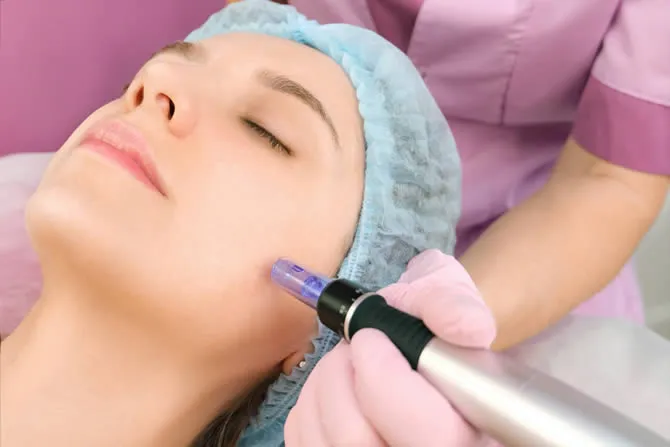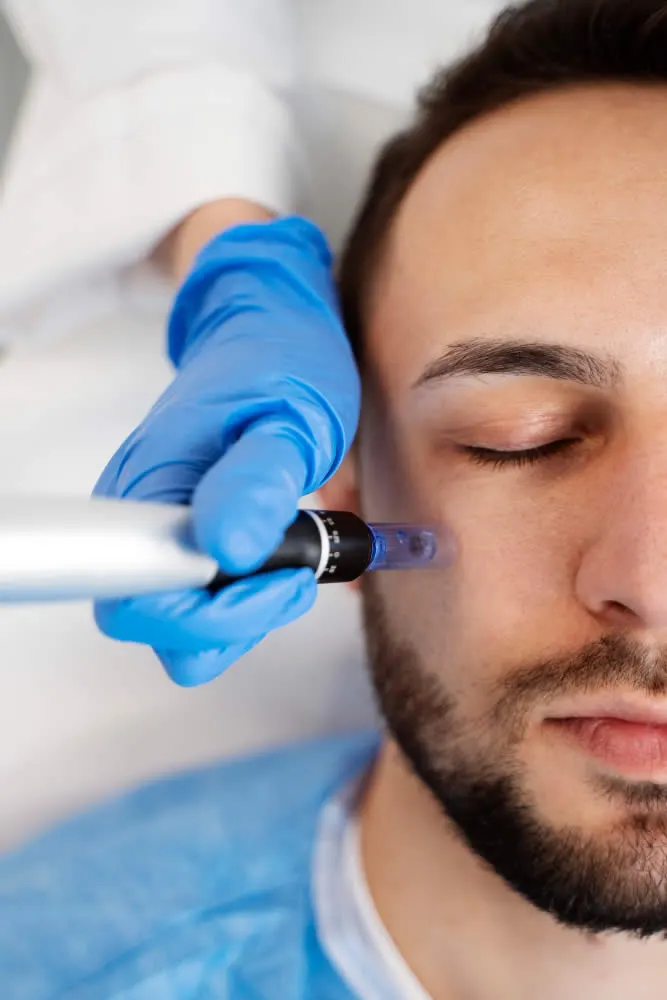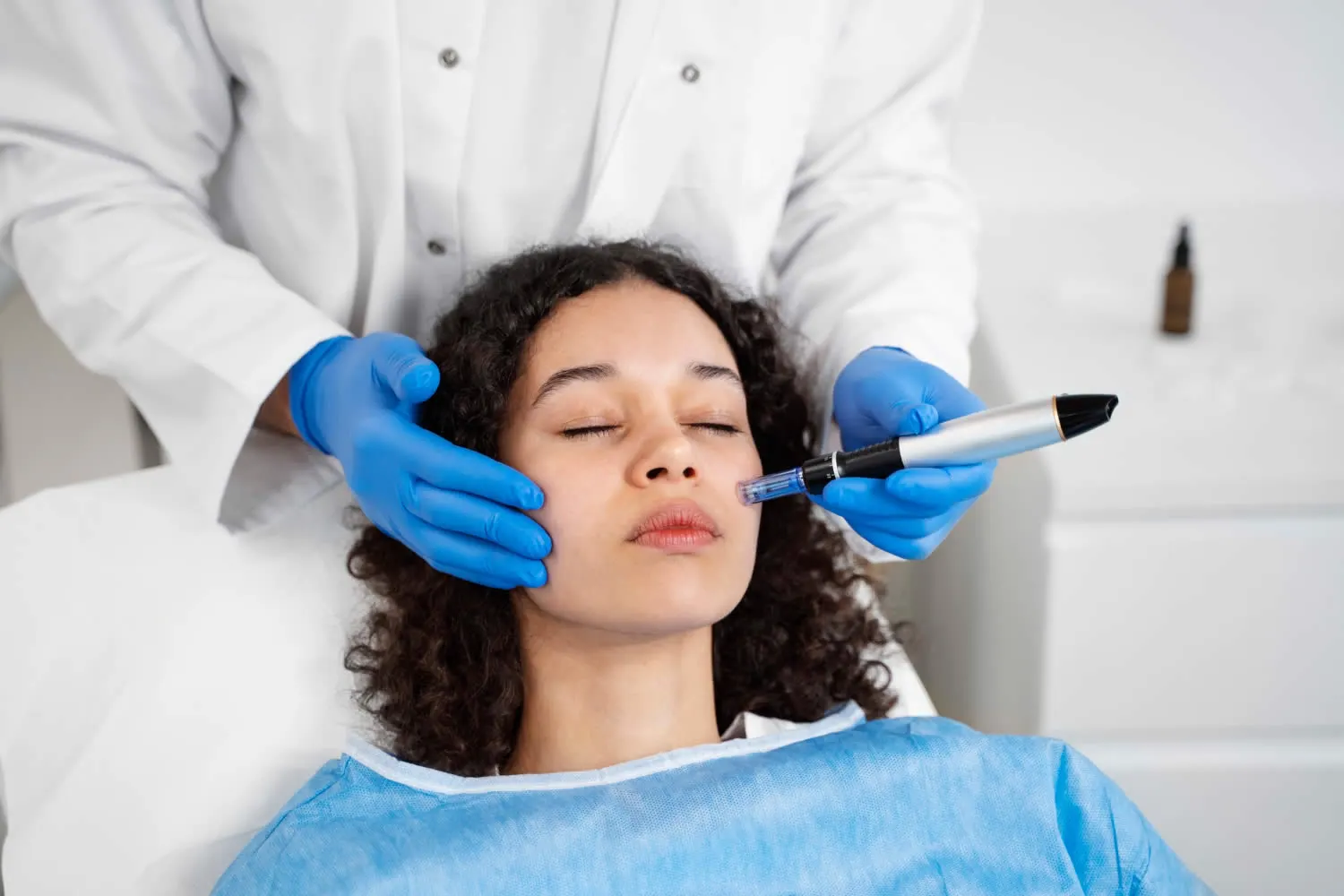What is Microneedling?
Microneedling is a minimally invasive skin treatment wherein a dermatologist employs slender needles to create minuscule punctures in the topmost layer of the skin. This intentional minor damage triggers the skin’s innate healing mechanisms, leading to an upsurge in the production of collagen and elastin, the proteins essential for maintaining skin’s elasticity and smooth texture.
While the face is the most common area for microneedling, it’s also performed on other body parts like the legs, back, and neck, especially where signs of aging or skin damage are evident. Several treatment sessions might be necessary to attain the desired rejuvenation.

Who undergoes Microneedling?
Microneedling serves both cosmetic and therapeutic purposes. Individuals often opt for microneedling when they have aesthetic concerns like:
- Enlarged pores.
- Fine lines and wrinkles.
- Skin that is loose or exhibits a crepey texture is characterized by being thin and finely wrinkled.
- Mild scars, particularly those resulting from acne or burns.
- Discolorations or inconsistencies in skin tone.
- Stretch marks.
Beyond the realm of cosmetic enhancements, microneedling also provides relief for specific medical conditions, such as:
- Alopecia areata is an autoimmune disorder causing hair loss.
- Hyperhidrosis is a condition characterized by excessive sweating.
Benefits of Microneedling
Microneedling offers an array of benefits for skin enhancement and rejuvenation. One of its primary advantages is its ability to refine the skin’s appearance and texture notably. Whether it’s diminishing the visibility of stretch marks, scars, wrinkles, or other skin imperfections, microneedling is a compelling solution. Importantly, unlike certain facial rejuvenation techniques that employ heat, light, or lasers, microneedling doesn’t pose the risk of skin discoloration.
This particular benefit makes it an especially attractive option for individuals with darker skin tones, ensuring they can achieve desired results without worrying about uneven skin coloration. All in all, microneedling presents itself as an effective and inclusive treatment for many skin concerns.
What happens during Microneedling?
During a microneedling session, the procedure starts with your healthcare provider ensuring your skin is thoroughly cleaned. A numbing cream or ointment, typically lidocaine gel, is applied to the skin for comfort. This is left on for about 30 to 45 minutes before the procedure, giving it ample time to take effect.
Once the area is sufficiently numbed, the provider will employ either a handheld roller with tiny needles or an electric device to create controlled wounds on the skin’s surface. When using the roller, it’s passed gently across the skin, whereas the electric device utilizes pulsating needles for the punctures. The electric device offers flexibility, as the needle length can be adjusted based on the treatment needs. For example, deeper scars or acne pockmarks may necessitate longer needles, ranging from 0.5 to 2 millimeters.
As the microneedling begins, patients might experience a sensation of warmth or a feeling akin to scratching. Certain areas, especially close to bones like the cheekbones, might induce slight discomfort. Deeper microneedling sessions can occasionally lead to minimal bleeding.
The procedure duration varies, taking anywhere from 15 minutes to a few hours, largely depending on the size of the treatment area.
Post-procedure, microneedling is categorized as an outpatient treatment, allowing you to head home once completed. It’s not uncommon for the skin to appear red and slightly swollen for up to five days following. Using an ice pack can be beneficial in alleviating any irritation or discomfort. While many resume wearing makeup the following day, avoiding direct sun exposure is crucial until the skin fully recuperates.
Who isn’t a good candidate for Microneedling?
While microneedling is generally safe for a broad range of individuals and diverse skin tones, it’s crucial to recognize that not every treatment suits everyone.
Microneedling might not be the right choice for those who:
- Exhibit slow or subpar healing abilities.
- Have experienced or currently have a keloid or raised scarring.
- Possess a compromised immune system due to underlying medical conditions or medication.
- Are undergoing treatment for skin cancer in the desired microneedling area.
- Are currently receiving radiation treatments.
Other circumstances might require postponement of the microneedling procedure. A dermatologist might delay the treatment if an individual:
- Has recently tanned or been exposed to substantial sunlight.
- Is suffering from a skin infection.
- Displays painful pimples filled with pus or extends deep within the skin.
For those with a recent tan, sunburn, skin infections, or breakout, it’s vital to let the skin recover before undergoing microneedling. For those on isotretinoin, at least one month should elapse after the last dosage before considering the procedure.

FAQ About Microneedling
Can you combine Microneedling with other skincare treatments?
Many dermatologists often combine microneedling with other treatments like chemical peels or serums, but it’s crucial to consult with a professional to determine what’s best for your skin.
Are there any side effects to Microneedling?
Potential side effects include redness, swelling, and minor bruising. Infections are rare but can occur if the treated area isn’t kept clean.
How long do the results from Microneedling last?
The results can be long-lasting, especially when paired with a good skincare routine. However, as with all cosmetic procedures, the longevity of results can vary from person to person.
Is there any age limit for undergoing Microneedling?
There’s no specific age limit, but it’s typically recommended for adults. Minors should always have parental consent and be assessed by a dermatologist.
Is there a dermatologist near me in Spokane that offers Microneedling treatment?
Yes. At our Spokane dermatology office we offer Microneedling treatment to patients from Spokane and the surrounding area. Contact our office today to schedule an appointment.

